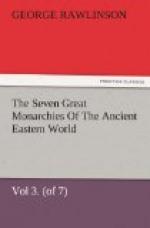The custom of divining by means of a number of rods appears to have been purely Magian. There is no trace of it in the Gathas, in the Yagna haptanhaiti, or in the older portions of the Vendidad. It was a Scythic practice; and probably the best extant account of it is that which Herodotus gives of the mode wherein it was managed by the Scyths of Europe. “Scythia,” he says, “has an abundance of soothsayers, who foretell the future by means of a number of willow wands. A large bundle of these rods is brought and laid on the ground. The soothsayer unties the bundle, and places each wand by itself, at the same time uttering his prophecy: then, while he is still speaking, he gathers the rods together again, and makes them up once more into a bundle.” A divine power seems to have been regarded as resting in the wands; and they were supposed to be “consulted” on the matter in hand, both severally and collectively. The bundle of wands thus imbued with supernatural wisdom became naturally part of the regular priestly costume, and was carried by the Magi on all occasions of ceremony. The wands were of different lengths; and the number of wands in the bundle varied. Sometimes there were three, sometimes five, sometimes as many as seven or nine; but in every case, as it would seem, an odd number.
Another implement which the priests commonly bore must be regarded, not as Magian, but as Zoroastrian. This is the khrafgthraghna, or instrument for killing bad animals, frogs, toads, snakes, mice, lizards, flies, etc., which belonged to the bad creation, or that which derived its origin from Angro-mainyus. These it was the general duty of all men, and the more especial duty of the Zoroastrian priests, to put to death, whenever they had the opportunity. The Magi, it appears, adopted this Arian usage, added the khrafgthraghna to the barsom, and were so zealous in their performance of the cruel work expected from them as to excite the attention, and even draw upon themselves the rebuke, of foreigners.
A practice is assigned to the Magi by many classical and ecclesiastical writers, which, if it were truly charged on them, would leave a very dark stain on the character of their ethical system. It is said that they allowed and even practised incest of the most horrible kind—such incest as we are accustomed to associate with the names of Lot, OEdipus, and Herod Agrippa. The charge seems to have been first made either by Xanthus the Lydian, or by Ctesias. It was accepted, probably without much inquiry, by the Greeks generally, and then by the Romans, was repeated by writer after writer as a certain fact, and became finally a stock topic with the early Christian apologists. Whether it had any real foundation in fact is very uncertain. Herodotus, who collects with so much pains the strange and unusual customs of the various nations whom he visits, is evidently quite ignorant of any such monstrous practice. He regards the Magian religion as established in Persia,




